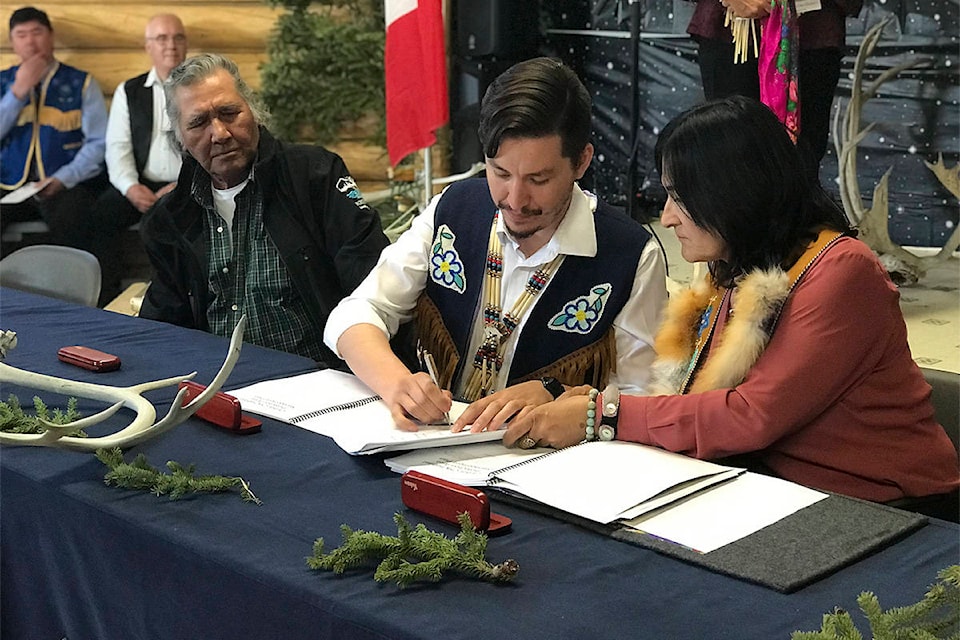A large swath of land in northern Yukon is now protected, and central to it is that Indigenous traditions remain intact.
“What this really does is protect our Gwich’in inheritance, our Gwich’in wealth, because this area is a major driver of plants and animals,” said Dana Tizya-Tramm, chief of Vuntut Gwitchin First Nation. “This is really a Gwich’in trust, a Gwich’in bank account.”
On May 17, the Yukon government, Vuntut Gwitchin and North Yukon Renewable Resource Council signed the Ch’ihilii Chik Habitat Protection Area Management Plan (HPA). The development stems from the North Yukon Regional Land Use Plan, which was approved in 2009. It recommended special management of the area.
Ch’ihilii Chik, which roughly translates as “where fish come out of the lake” in Gwich’in, is a 468-square kilometre tract. Roughly 75 per cent of it is Settlement A lands belonging to Vuntut Gwitchin. The rest is public land (110-square kilometres.)
It’s approximately 120 kilometres southeast of Old Crow.
There are roughly 1,000 water bodies within the area, according to the management plan, Whitefish Lake being the largest. Its waterways are “relatively undisturbed.”
“Ch’ihilii Chik is a legacy, and it’s a closing of a lot of work by a self-governing First Nation,” Tizya-Tramm said. “Now we have about 31,000-square kilometres protected in our traditional territory, which is just incredible. Vuntut Gwitchin has now fully satisfied everything that we had set out to protect in the inception of our agreements. This is the closing of a very big chapter, not to say we’re completely finished. There’s always going to new considerations in new areas.”
Next to the Old Crow Flats, Ch’ihilii Chik is the “most significant wetland complex” in Vuntut Gwitchin’s traditional territory, the management plan says.
It’s home to whitefish, beavers, moose, Porcupine caribou and waterfowl, among other animals.
Protecting them and their habitats is the objective of the management plan. But it goes further.
“The ability of the Ch’ihilii Chik HPA to provide subsistence and cultural nourishment to the Vuntut Gwitchin is economically and culturally important, and is the foundation for this management plan,” it says, noting that the area is used by Old Crow residents for hunting, fishing, trapping and exposing youth to traditional activities.
“It guards First Nation practices,” Tizya-Tramm said. “This also represents major protection for animals. This area is for them and it’s for those ecosystems to continue and sustain Gwich’in and Gwich’in culture.”
Yukon Environment Minister Pauline Frost said that Vuntut Gwitchin has the largest land protection regime falling under a tripartite arrangement in the Yukon.
She called the development “precedent-setting” for the Yukon government.
“We want to ensure that we look at cultural integration when we look at land management or we look at resource management. The establishment, like other habitat areas, is intended to preserve habitat, conserve natural resources and the most important thing is safeguarding traditional practices of the Indigenous people of the area.
“Cultural integrity is really important to respecting rights of Indigenous people, in this case of Vuntut Gwitchin.”
Industrial development has no place in Ch’ihilii Chik. Oil, gas and mineral exploration and extraction are permanently prohibited in the area, according to the management plan, along with commercial and other industrial activities.
These, the management plan says, are incompatible with objectives. An assessment indicated that area has low mineral potential.
The prohibitions took effect when the plan was signed last week, said Environment Yukon spokesperson Diana Dryburgh-Moraal in a written statement.
“Ch’ihilii Chik has been withdrawn from oil, gas and mineral exploration and development since 2009, when it was identified for protection in the North Yukon land use plan,” she said, adding that the prohibitions are a continuation of this.
There are no quartz or placer claims, oil, gas permits or coal licenses in the habitat protection area, Dryburgh-Moraal said.
“Tourism opportunities will need to be carefully considered to ensure they do not impact the traditional use and ecological values of the area and respect the objectives of this management plan,” the management plan says, noting that they may be considered on a case-by-case basis.
In total, the plan has 32 recommendations. They include keeping track of subsistence harvesting, establishing a research cabin in the area and that the management plan be referenced when environmental reviews are conducted concerning environmental issues that fall outside the boundary of Ch’ihilii Chik.
Now that the plan has been approved, the three parties are to review its implementation within five years.
“Through implementation, this management plan is intended to maintain an intact ecosystem, including healthy wildlife populations, for the Ch’ihilii Chik HPA,” the management plan says. “It should encourage local use of the area, and provide clarity for land users in the area.”
Contact Julien Gignac at julien.gignac@yukon-news.com
